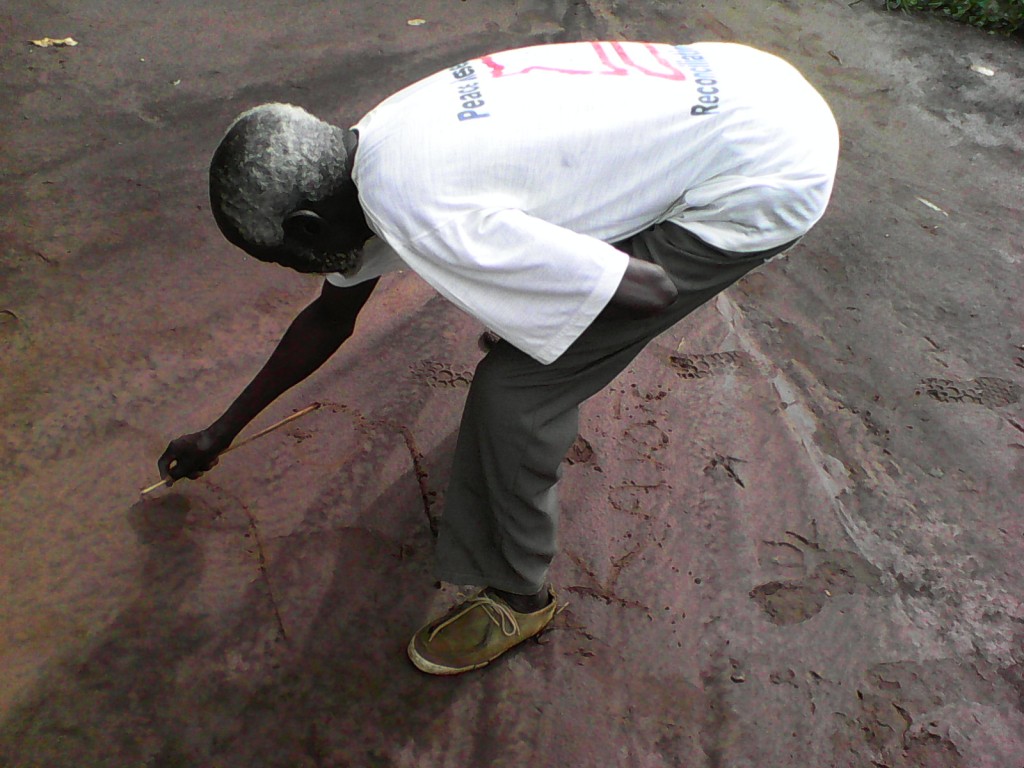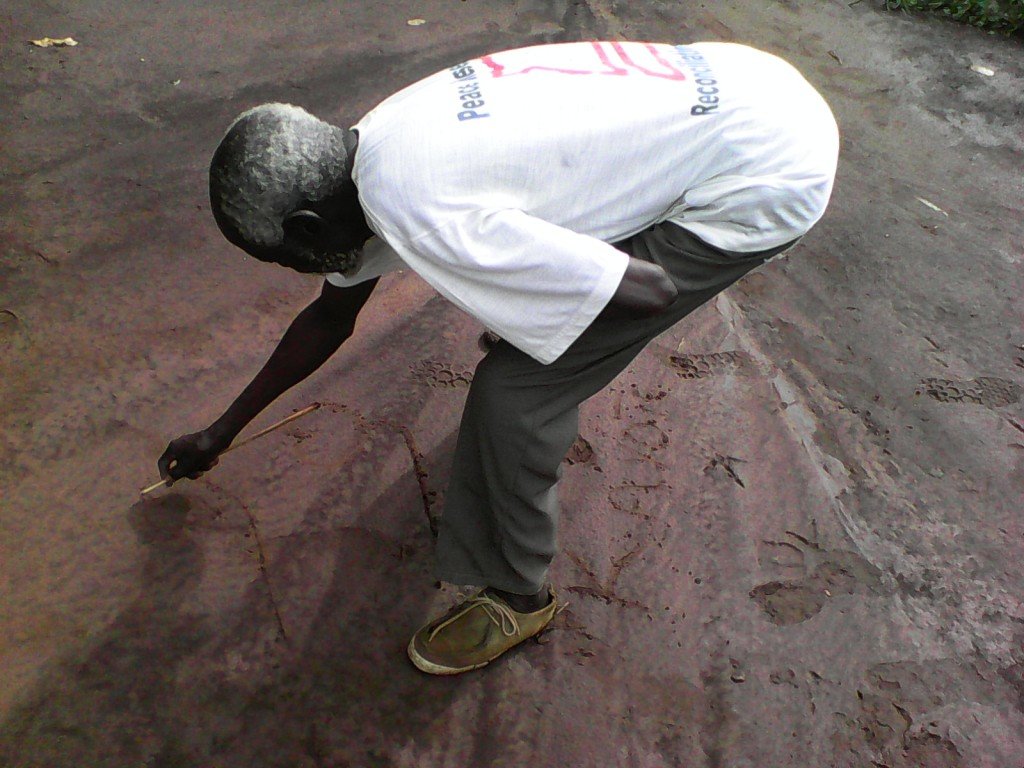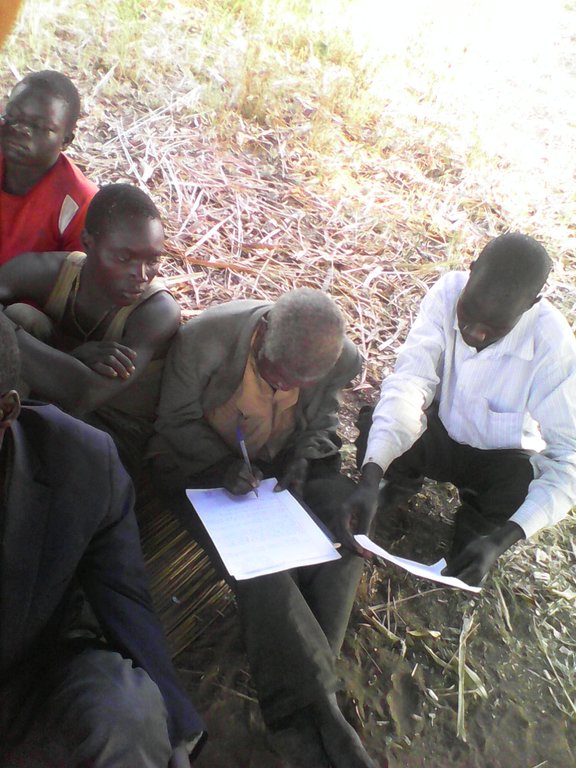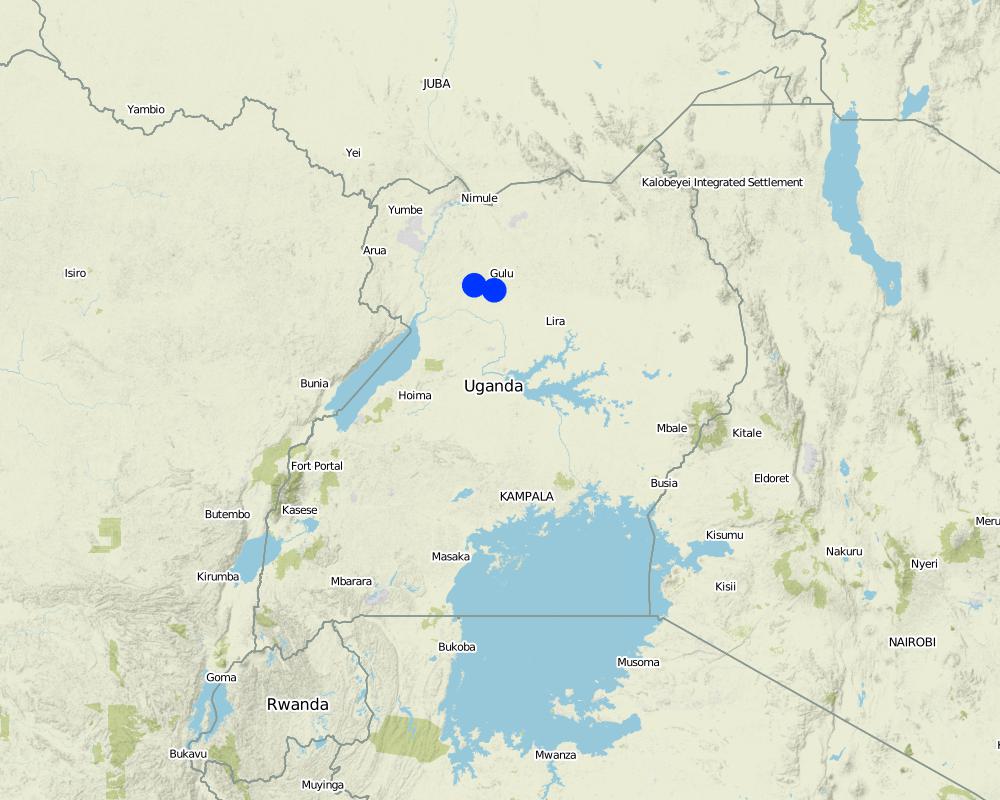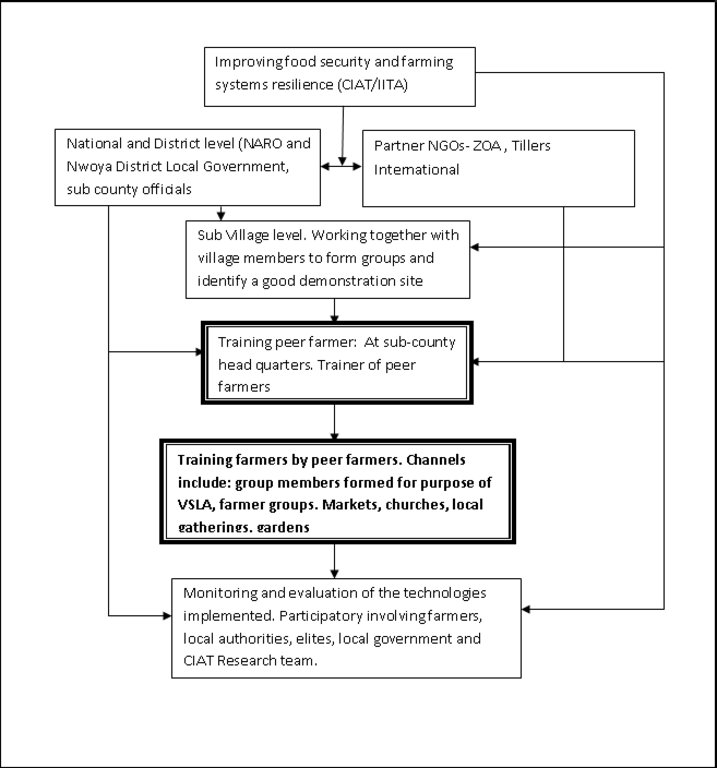Peer farmers as a village resource person for scaling Climate-Smart Agriculture (CSA) Practices [ยูกันดา]
- ผู้สร้างสรรค์:
- การอัพเดท:
- ผู้รวบรวม: Sunday Balla Amale
- ผู้เรียบเรียง: JOY TUKAHIRWA, Kamugisha Rick Nelson
- ผู้ตรวจสอบ: John Stephen Tenywa, Nicole Harari
Lawang Lupur (Rwot Kweri)
approaches_3323 - ยูกันดา
ดูส่วนย่อย
ขยายทั้งหมด ย่อทั้งหมด1. ข้อมูลทั่วไป
1.2 รายละเอียดที่ติดต่อได้ของผู้รวบรวมและองค์กรที่เกี่ยวข้องในการประเมินและการจัดเตรียมทำเอกสารของแนวทาง
วิทยากรหลัก
ผู้ใช้ที่ดิน:
Odong Kilama
0777229172
Farmer
Laliya, Agung, Akaka Sub-county
ยูกันดา
Sunday Micheal
+256782139465
Farmer
gweno twom south, Nwoya village, Alero sub county, Nwoya District
ยูกันดา
ชื่อของโครงการซึ่งอำนวยความสะดวกในการทำเอกสารหรือการประเมินแนวทาง (ถ้าเกี่ยวข้อง)
Scaling-up SLM practices by smallholder farmers (IFAD)ชื่อของโครงการซึ่งอำนวยความสะดวกในการทำเอกสารหรือการประเมินแนวทาง (ถ้าเกี่ยวข้อง)
Uganda Landcare Network (ULN) - ยูกันดา1.3 เงื่อนไขที่เกี่ยวข้องกับการใช้ข้อมูลที่ได้บันทึกไว้ผ่านทาง WOCAT
วันที่เก็บรวบรวมข้อมูล (ภาคสนาม):
12/12/2017
ผู้รวบรวมและวิทยากรหลักยอมรับเงื่อนไขเกี่ยวกับการใช้ข้อมูลที่ถูกบันทึกผ่านทาง WOCAT:
ใช่
1.4 การอ้างอิงถึงแบบสอบถามเรื่องเทคโนโลยี SLM
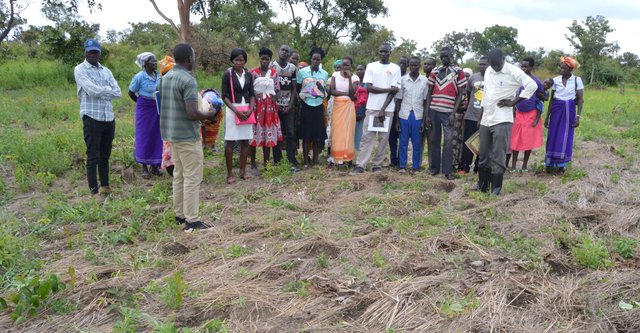
Conservation Farming Basins In Annual Crops For Water … [ยูกันดา]
CF basins are constructed in the field to act as water storage containers. Water is conserved within the basins and plants can survive with this conserved water during periods of little rainfall and dry spells.
- ผู้รวบรวม: Sunday Balla Amale
2. คำอธิบายของแนวทาง SLM
2.1 การอธิบายแบบสั้น ๆ ของแนวทาง
A prosocial behavior approach, where a peer farmer identified by other local farmers is trained on a technology and then used as a trainer for the fellow farmers (farmer group or neighbors).
2.2 การอธิบายอย่างละเอียดของแนวทาง
การอธิบายอย่างละเอียดของแนวทาง:
Adoption of sustainable agricultural practices requires an in-depth understanding of the implementation, sustainability and the opportunity cost involved. Empowered local resource persons known as peer farmers are used by the International Center for Tropical Agriculture (CIAT) and International Institute of Tropical Agriculture (IITA) in Northern Uganda as channels to ensure that farmers understand the importance and implementation of Climate Smart Agricultural (CSA) Practices such as using conservation farming (CF) permanent basins.
A peer farmer in this case is a local community member whom the farmers identify as a potential trainer, very cooperative and, if trained would be willing to share the knowledge with other farmers in that community. After training the peer farmers, an incentive is promised to them based on their performance over time. This incentive is a commodity that is very cheap, but valuable, and not usually a farm input. In this case weighing scale was used as an incentive.
The peer farmer then uses all available methods and channels to pass on to the knowledge to other folks. The acquired knowledge and skills are usually shared through community meetings, religious gatherings, market places and so on.
The process of implementing this approach includes: Identifying the place of implementation, working with the farmers to identify a potential peer farmer, training the peer farmer, the peer farmer training other farmers over time and monitoring the progress of knowledge spill over. Stakeholders involved: Field staff - Work with farmers to identify and train peers, monitor activities; local leaders - organize community members; peer farmer - attend training, train other farmers.
This method is cheap, farmers identify someone with fairly good pro-social behavior, and farmers would be willing to learn from their own village member.
2.3 รูปภาพของแนวทาง
2.5 ประเทศ ภูมิภาค หรือสถานที่ตั้งที่ได้นำแนวทางไปใช้
ประเทศ:
ยูกันดา
ภูมิภาค/รัฐ/จังหวัด: :
Nwoya District
ข้อมูลเฉพาะเพิ่มเติมของสถานที่ตั้ง:
Alero Sub-county
Map
×2.6 วันที่เริ่มต้นและสิ้นสุดของแนวทาง
ระบุปีที่เริ่ม:
2015
ถ้าไม่รู้ปีที่แน่นอนให้ประมาณวันที่ที่ริเริ่มใช้แนวทางนี้ :
น้อยกว่า 10 ปี (เร็วๆนี้)
2.7 ประเภทของแนวทาง
- ใช้โครงงานหรือแผนงานเป็นฐาน
2.8 เป้าหมายหรือวัตถุประสงค์หลักของแนวทาง
Promoting adoption of Climate-Smart Agriculture through prosocial behaviour
2.9 เงื่อนไขที่เอื้ออำนวยหรือเป็นอุปสรรคต่อการนำเทคโนโลยีภายใต้แนวทางนี้ไปปฏิบัติใช้
บรรทัดฐานและค่านิยมทางสังคม วัฒนธรรม ศาสนา
- เอื้ออำนวย
traditional relations among local communities
- เป็นอุปสรรค
limited cooperation among some communities
การจัดตั้งระดับองค์กร
- เอื้ออำนวย
Agricultural Advisory services in the country, more NGOs operating in the agricultural sector
การร่วมมือหรือการทำงานประสานกันของผู้ลงมือปฏิบัติ
- เอื้ออำนวย
Participatory involvement of all the stakeholders in the agricultural sector
นโยบาย
- เอื้ออำนวย
PMA-Plan for Modernisation of Agriculture, a Government policy aimed at ensuring adoption of modern farming technologies.
Policy Action on climate change adaptation
Vision 2040 - A government policy aims at transforming Uganda's agriculture from subsistence to commercial farming.
ความรู้เกี่ยวกับ SLM การเข้าถึงการสนับสนุนด้านเทคนิค
- เอื้ออำนวย
Trainings from different agencies
- เป็นอุปสรรค
costs to fund the training of peer farmers
ตลาด (จัดซื้อปัจจัยนำเข้า ขายผลิตภัณฑ์) และราคา
- เอื้ออำนวย
high demands for food produce and favorable market prices with good roads
- เป็นอุปสรรค
middle men cheat poor farmers
ปริมาณงานที่ทำได้ กำลังคนที่มีให้
- เอื้ออำนวย
use local people at their own times
- เป็นอุปสรรค
illiteracy
3. การมีส่วนร่วมและบทบาทของผู้มีส่วนได้ส่วนเสียที่เกี่ยวข้อง
3.1 ผู้มีส่วนได้ส่วนเสียที่เกี่ยวข้องในแนวทางนี้และบทบาท
- ผู้ใช้ที่ดินระดับท้องถิ่นหรือชุมชนระดับท้องถิ่น
farmers and local leaders
implement the technology
- องค์กรที่ขึ้นอยู่กับชุมชน
farmer groups
used as a channel
- ผู้เชี่ยวชาญ SLM หรือที่ปรึกษาการเกษตร
extension workers
train on the SLM technologies
- นักวิจัย
CIAT/IITA
Assess the degree of resilience
- องค์การระหว่างประเทศ
CIAT/IITA
funding research activities
ถ้ามีผู้มีส่วนได้ส่วนเสียหลายคนที่เกี่ยวข้องให้ระบุหน่วยงานตัวแทน:
CIAT
3.2 การเกี่ยวข้องของผู้ใช้ที่ดินระดับท้องถิ่นหรือชุมชนระดับท้องถิ่นในช่วงต่างๆของแนวทาง
| ความเกี่ยวข้องของผู้ใช้ที่ดินระดับท้องถิ่นหรือชุมชนระดับท้องถิ่น | ระบุผู้ที่มีส่วนเกี่ยวข้องและอธิบายกิจกรรม | |
|---|---|---|
| การริเริ่มหรือการจูงใจ | จ่ายเงินหรือสนับสนุนจากภายนอก | CIAT project promoting food security and farming systems resilience in East Africa through wide-scale adoption of climate smart agriculture. The project is implemented in Nwoya district, designed by CIAT and funded by IFAD. |
| การวางแผน | จ่ายเงินหรือสนับสนุนจากภายนอก | CIAT/IITA: IITA became partner organisation for the project. Staffing was done through IITA, implemented in collaboration with IITA Uganda. |
| การดำเนินการ | ปฏิสัมพันธ์ | CIAT, IITA, Local government, National Agricultural Research Organisation, ZOA, Farmers, Extension agents |
| การติดตามตรวจสอบหรือการประเมินผล | ปฏิสัมพันธ์ | Participatory monitoring and evaluation involving all parties through farmers field days |
3.3 แผนผังแสดงขั้นตอนการทำงาน (ถ้ามี)
คำอธิบาย:
detailed chart showing the different planyers in the approach
ผู้เขียน:
Amale Balla Sunday
3.4 การตัดสินใจเลือกใช้เทคโนโลยี SLM
ระบุผู้ที่ทำการตัดสินใจเลือกเทคโนโลยีมากกว่าหนึ่งวิธีไปปฏิบัติใช้:
- ผู้ลงมือปฏิบัติที่เกี่ยวข้องทั้งหมดในฐานะที่เป็นส่วนรวมของแนวทาง
ระบุว่าการตัดสินใจตั้งอยู่บนพื้นฐานของ:
- การประเมินความรู้ SLM ที่ได้ทำการบันทึกไว้เป็นอย่างดี (การใช้ข้อมูลในการตัดสินใจ)
- สิ่งที่ค้นพบจากงานวิจัย
4. การสนับสนุนด้านเทคนิค การสร้างขีดความสามารถ และการจัดการด้านความรู้
4.1 การสร้างขีดความสามารถ / การอบรม
ได้มีการจัดอบรมให้แก่ผู้ใช้ที่ดินหรือผู้มีส่วนได้ส่วนเสียคนอื่น ๆ หรือไม่:
ใช่
ให้ระบุว่าใครเป็นผู้ได้รับการอบรม:
- ผู้ใช้ที่ดิน
ถ้าเกี่ยวข้อง ให้ระบุ เพศ อายุ สถานภาพ ชาติพันธุ์ เป็นต้น:
adults
รูปแบบการอบรม:
- จัดการประชุมสู่สาธารณชน
4.2 การบริการให้คำแนะนำ
ผู้ใช้ที่ดินมีการเข้าถึงการรับบริการให้คำปรึกษาหรือไม่:
ใช่
ระบุว่ามีบริการให้คำปรึกษาหรือไม่:
- ไปเยี่ยมชมสถานที่
การอธิบาย/แสดงความคิดเห็น:
planned visits to peer farmers fields to observe what they are doing and advising them accordingly.
4.3 การเสริมความแข็งแกร่งให้กับสถาบัน (การพัฒนาองค์กร)
สถาบันได้รับการจัดตั้งขึ้นมาหรือเสริมความแข็งแกร่งโดยแนวทางนี้หรือไม่:
- ใช่ เล็กน้อย
ระบุระดับของสถาบันที่ได้รับการเสริมความแข็งแกร่งหรือจัดตั้งขึ้นมา:
- ท้องถิ่น
อธิบายถึงสถาบัน บทบาทและความรับผิดชอบ สมาชิก เป็นต้น:
local farmer groups
ระบุประเภทของการให้ความช่วยเหลือสนับสนุน:
- การสร้างขีดความสามารถ / การอบรม
4.4 การติดตามตรวจสอบและประเมินผล
การติดตามตรวจสอบและประเมินผลเป็นส่วนหนึ่งของแนวทางหรือไม่:
ใช่
ถ้าตอบว่าใช่ แสดงว่าการจัดเตรียมเอกสารนี้มุ่งหวังที่จะเอาไปใช้สำหรับการติดตามตรวจสอบและประเมินผลใช่หรือไม่:
ไม่ใช่
4.5 การวิจัย
การวิจัยเป็นส่วนหนึ่งของแนวทางหรือไม่:
ใช่
ระบุหัวข้อเรื่อง:
- สังคมวิทยา
- เศรษฐศาสตร์หรือการตลาด
ให้ข้อมูลเพิ่มเติมและให้ระบุผู้ทำการวิจัย:
CIAT/IITA Research in Northern Uganda under the project; Promoting food security and farming systems resilience in East Africa through wide scale adoption of climate smart Agriculture (CSA)
5. การสนับสนุนด้านการเงินและวัสดุอุปกรณ์
5.1 ระบุงบประมาณประจำปีสำหรับแนวทาง SLM นี้
ถ้าหากว่างบประมาณประจำปีไม่เป็นที่ทราบแน่นอน ให้ระบุช่วงลงไป:
- 2,000-10,000
5.2 การสนับสนุนด้านการเงิน / วัสดุอุปกรณ์ให้แก่ผู้ใช้ที่ดิน
ผู้ใช้ที่ดินได้รับการสนับสนุนด้านการเงิน / วัสดุอุปกรณ์ไปปฏิบัติใช้เทคโนโลยีหรือไม่:
ไม่ใช่
5.3 เงินสนับสนุนสำหรับปัจจัยนำเข้า (รวมถึงแรงงาน)
- ไม่มี
ถ้าแรงงานโดยผู้ใช้ที่ดินเป็นปัจจัยนำเข้าที่มีอยู่มากมาย ระบุด้วยว่าเนื่องจาก:
- สมัครใจ
5.4 เครดิต
มีการจัดหาเครดิตมาให้ภายใต้แนวทาง SLM หรือไม่:
ไม่ใช่
5.5 แรงจูงใจหรือเครื่องมืออื่น ๆ
แรงจูงใจหรือเครื่องมืออื่น ๆ ได้ถูกนำไปใช้ส่งเสริมการใช้เทคโนโลยี SLM หรือไม่:
ใช่
ถ้าใช่ ระบุ:
weighing scale for best performers
6. การวิเคราะห์ผลกระทบและการสรุป
6.1 ผลกระทบของแนวทาง
ทำให้ผู้ใช้ที่ดินระดับท้องถิ่นมีอำนาจขึ้น ปรับปรุงการเข้าร่วมของผู้มีส่วนได้ส่วนเสียให้ดีขึ้นหรือไม่:
- ไม่ใช่
- ใช่ เล็กน้อย
- ใช่ ปานกลาง
- ใช่ อย่างมาก
yes, improved group work
ช่วยในการตัดสินใจโดยดูจากหลักฐาน ได้หรือไม่:
- ไม่ใช่
- ใช่ เล็กน้อย
- ใช่ ปานกลาง
- ใช่ อย่างมาก
decision made by community members
ช่วยให้ผู้ใช้ที่ดินนำเอาเทคโนโลยี SLMไปใช้และบำรุงรักษาสภาพไว้ได้หรือไม่:
- ไม่ใช่
- ใช่ เล็กน้อย
- ใช่ ปานกลาง
- ใช่ อย่างมาก
incentive driven
ปรับปรุงความร่วมมือกันและการดำเนิน งานของ SLM ได้อย่างมีประสิทธิผลหรือไม่:
- ไม่ใช่
- ใช่ เล็กน้อย
- ใช่ ปานกลาง
- ใช่ อย่างมาก
farmers working with each other
ระดมกำลังหรือปรับปรุงการเข้าถึงแหล่ง เงินทุนสำหรับการดำเนินการ SLM หรือไม่:
- ไม่ใช่
- ใช่ เล็กน้อย
- ใช่ ปานกลาง
- ใช่ อย่างมาก
promoted group work but directed towards technology transfer
ปรับปรุงความรู้และความสามารถของผู้ใช้ที่ดินในการดำเนินการ SLM หรือไม่:
- ไม่ใช่
- ใช่ เล็กน้อย
- ใช่ ปานกลาง
- ใช่ อย่างมาก
new technologies
ปรับปรุงความรู้และความสามารถของผู้มีส่วนได้ส่วนเสียคนอื่น ๆ ให้ดีขึ้นหรือไม่:
- ไม่ใช่
- ใช่ เล็กน้อย
- ใช่ ปานกลาง
- ใช่ อย่างมาก
mostly farmers involved
ทำให้ผู้ใช้ที่ดินระดับท้องถิ่นมีอำนาจขึ้น ปรับปรุงการเข้าร่วมของผู้มีส่วนได้ส่วนเสียให้ดีขึ้นหรือไม่:
- ไม่ใช่
- ใช่ เล็กน้อย
- ใช่ ปานกลาง
- ใช่ อย่างมาก
different stakeholders participated
ช่วยบรรเทาความขัดแย้งหรือไม่:
- ไม่ใช่
- ใช่ เล็กน้อย
- ใช่ ปานกลาง
- ใช่ อย่างมาก
improved social relations
ทำให้กลุ่มด้อยโอกาสมีอำนาจทางสังคมและเศรษฐกิจหรือไม่:
- ไม่ใช่
- ใช่ เล็กน้อย
- ใช่ ปานกลาง
- ใช่ อย่างมาก
did not focus on well off farmers, just anyone whom the community thinks has the potential to train local members
ปรับปรุงความทัดเทียมกันด้านเพศและให้อำนาจแก่ผู้หญิงและเด็กผู้หญิงหรือไม่:
- ไม่ใช่
- ใช่ เล็กน้อย
- ใช่ ปานกลาง
- ใช่ อย่างมาก
50% of trainers were women and at the end they performed better than the men trainers
ส่งเสริมให้เยาวชนหรือบุตรหลานของผู้ใช้ที่ดินให้เข้าร่วมใน SLM:
- ไม่ใช่
- ใช่ เล็กน้อย
- ใช่ ปานกลาง
- ใช่ อย่างมาก
ensure transfer to local people
ปรับปรุงประเด็นของการถือครองที่ดินหรือสิทธิในการใช้ ซึ่งขัดขวางการนำเทคโนโลยีไปใช้ให้ดีขึ้น:
- ไม่ใช่
- ใช่ เล็กน้อย
- ใช่ ปานกลาง
- ใช่ อย่างมาก
นำไปสู่ความมั่นคงด้านอาหารหรือปรับปรุงโภชนาการให้ดีขึ้น:
- ไม่ใช่
- ใช่ เล็กน้อย
- ใช่ ปานกลาง
- ใช่ อย่างมาก
much higher increase in production
ปรับปรุงการเข้าถึงตลาดหรือไม่:
- ไม่ใช่
- ใช่ เล็กน้อย
- ใช่ ปานกลาง
- ใช่ อย่างมาก
good quality products
นำไปสู่การเข้าถึงเรื่องน้ำและสุขาภิบาลได้ดีขึ้นหรือไม่:
- ไม่ใช่
- ใช่ เล็กน้อย
- ใช่ ปานกลาง
- ใช่ อย่างมาก
farm based
นำไปสู่การใช้ที่ดินอย่างยั่งยืนหรือแหล่งพลังงานหรือไม่:
- ไม่ใช่
- ใช่ เล็กน้อย
- ใช่ ปานกลาง
- ใช่ อย่างมาก
farm based
ปรับปรุงความสามารถของผู้ใช้ที่ดินในการปรับตัวให้เข้ากับการเปลี่ยนแปลงของสภาพภูมิอากาศหรือสภาพที่รุนแรงและภัยพิบัติหรือไม่:
- ไม่ใช่
- ใช่ เล็กน้อย
- ใช่ ปานกลาง
- ใช่ อย่างมาก
นำไปสู่โอกาสในการจ้างงาน รายได้หรือไม่:
- ไม่ใช่
- ใช่ เล็กน้อย
- ใช่ ปานกลาง
- ใช่ อย่างมาก
to trainers of peer farmers
6.2 แรงจูงใจหลักของผู้ใช้ที่ดินเพื่อที่จะนำ SLM ไปปฏิบัติใช้
- การผลิตที่เพิ่มขึ้น
reduced crop failure since farmers learnt better water conservation methods
- กำไร (ความสามารถ) อัตราส่วนค่าใช้จ่ายต่อผลประโยชน์ที่เพิ่มขึ้น
higher yields with lower investments
- การเสื่อมของที่ดินลดลง
reduced erosion and surface flow
- ความเสี่ยงของภัยพิบัติลดลง
crops do not fail during dry spells
- ภาระงานลดลง
performed once every 3 years, no need for irrigation
- เกียรติภูมิ แรงกดดันทางสังคม ความเชื่อมแน่นทางสังคม
working and training each other
- การเข้าร่วมสมทบในขบวนการ โครงการ กลุ่ม เครือข่าย
local group driven approach
- จิตสำนึกด้านสิ่งแวดล้อม
farmers learnt how important it is to conserve soils
- ความรู้และทักษะ SLM ที่เพิ่มพูนขึ้น
through trainings and social group work
- การปรับปรุงด้านสุทรียภาพ
good quality product
- การบรรเทาด้านความขัดแย้ง
good community relations
6.3 ความยั่งยืนของกิจกรรมของแนวทาง
ผู้ใช้ที่ดินสามารถทำให้สิ่งต่างๆ ที่ได้ปฏิบัติใช้โดยแนวทางนี้ยั่งยืนได้หรือไม่ (โดยไม่มีการสนับสนุนจากภายนอก):
- ใช่
ถ้าตอบว่าใช่ ให้อธิบายว่าอย่างไร :
The knowledge becomes local to the farmers; observes direct benefits whitin the shortest time of implementation, learn other things from neighbors without need for any motivation
6.4 จุดแข็งและข้อได้เปรียบของแนวทาง
| จุดแข็ง / ข้อได้เปรียบของแนวทางในทัศนคติของผู้ใช้ที่ดิน |
|---|
| farmers can easily learn from each other |
| peer trains farmers within their local environment |
| จุดแข็ง / ข้อได้เปรียบของแนวทางในทัศนคติของผู้รวบรวมหรือวิทยากรหลัก |
|---|
| All available methods of passing information about the technologies are at the peer farmers disposal eg. market points, church, group meetings, tribal gatherings |
| farmers use their local language to teach/demonstrate to each other |
6.5 จุดอ่อน / ข้อเสียเปรียบของแนวทางและวิธีในการแก้ไข
| จุดอ่อน / ข้อเสียเปรียบในทัศนคติของผู้ใช้ที่ดิน | สามารถแก้ไขปัญหาได้อย่างไร |
|---|---|
| difficult to train peer farmers | use practicals |
| peer farmers may not retain all the knowledge about the technology | use charts/pictures |
| จุดอ่อน / ข้อเสียเปรียบในทัศนคติของผู้รวบรวมหรือวิทยากรหลัก | สามารถแก้ไขปัญหาได้อย่างไร |
|---|---|
| costly to organise trainings for peers | use local education facilities such as schools for training peer farmers |
7. การอ้างอิงและการเชื่อมต่อ
7.1 วิธีการหรือแหล่งข้อมูล
- ไปเยี่ยมชมภาคสนาม การสำรวจพื้นที่ภาคสนาม
2
- การสัมภาษณ์กับผู้ใช้ที่ดิน
3
- การสัมภาษณ์ผู้เชี่ยวชาญด้าน SLM หรือผู้ชำนาญ
1
ลิงก์และโมดูล
ขยายทั้งหมด ย่อทั้งหมดลิงก์

Conservation Farming Basins In Annual Crops For Water … [ยูกันดา]
CF basins are constructed in the field to act as water storage containers. Water is conserved within the basins and plants can survive with this conserved water during periods of little rainfall and dry spells.
- ผู้รวบรวม: Sunday Balla Amale
โมดูล
ไม่มีโมดูล


